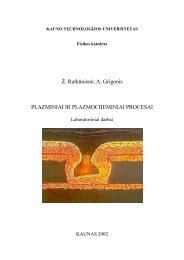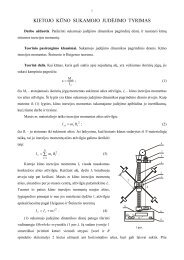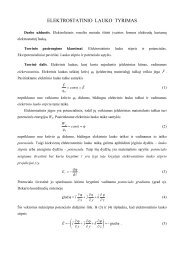PROCEEDINGS OF THE 7 INTERNATIONAL ... - Fizika
PROCEEDINGS OF THE 7 INTERNATIONAL ... - Fizika
PROCEEDINGS OF THE 7 INTERNATIONAL ... - Fizika
Create successful ePaper yourself
Turn your PDF publications into a flip-book with our unique Google optimized e-Paper software.
MEDICAL PHYSICS IN <strong>THE</strong> BALTIC STATES 7 (2009)<br />
Proceedings of International Conference “Medical Physics 2009”<br />
8 - 10 October 2009, Kaunas, Lithuania<br />
FIBER-OPTICS BASED LASER SYSTEM FOR 2-D FLUORESCENCE<br />
DETECTION AND OPTICAL BIOPSY<br />
Dalia KAŠKELYTĖ*, Arūnas ČIBURYS*, Saulius BAGDONAS*, Giedrė STRECKYTĖ*,<br />
Ričardas ROTOMSKIS* , **, Roaldas GADONAS*<br />
* Department of Quantum Electronics & Laser Research Center, Vilnius University. Saulėtekio ave. 9, bldg. 3, LT-<br />
10222 Vilnius, Lithuania;<br />
** Laboratory of Biomedical Physics, Institute of Oncology of Vilnius University. P. Baublio 3, LT-08406 Vilnius,<br />
Lithuania<br />
Abstract: The constructed fluorescence excitation / collection unit was specifically designed to utilize a single fiber<br />
probe for excitation of a green fluorescing marker and its emission collection within the sample depth. Model layered<br />
specimens consisting of a slice of rhodamine 6G stained gelatine or suspension of PKH 67 marked cells incorporated<br />
between gelatine-milk slices were used to characterize the performance of the constructed system. Localization of the<br />
green fluorescing markers was evaluated with the needle based fiber probe tip registering fluorescence spectra at<br />
various probing depths. Experimental results demonstrate the sensitivity of the fiber-optics based laser system in<br />
measuring thin fluorescing objects within the model layered specimen. The obtained spatial resolution was better than 1<br />
mm which is basically due to the active fiber probe dimensions.<br />
Keywords: fluorescence, optical biopsy<br />
1. Introduction<br />
There are many fields in biomedicine where fiber<br />
based optical probes are used for fluorescence<br />
diagnostics and imaging purposes [1,2]. Fluorescence<br />
probes that can collect and distinguish depth-related<br />
spectroscopic data representing tissue optical<br />
signatures from those of native chromophores or<br />
supplied molecular markers have important diagnostic<br />
significance. Information concerning the localization<br />
and distribution of fluorescing substance within the<br />
biological tissue as well as its specific optical<br />
signatures may improve the facilities of fiber-optic<br />
spectroscopy methods to evaluate biochemical<br />
alterations or tissue viability during the real-time<br />
measurements.<br />
The goal of this work was to construct the portable unit<br />
for fluorescence measurements based on fiber-optics<br />
and the laser system, which would be sensitive to the<br />
labelled object localized within tissue (cells) volume of<br />
20<br />
about a few cubic millimetres. The premises of the<br />
present work deal with the problem of the in vivo<br />
detection of cells labelled by a fluorescent marker<br />
within the tissue.<br />
2. Materials and methods<br />
We used a diode-pumped solid state laser (DPSSL)<br />
operating in cw regime at the wavelength 473 nm with<br />
tunable output power up to 15 mW to excite<br />
fluorescence of molecular markers inoculated into<br />
biological tissue. A spectrometer (Avaspec-2048,<br />
Avantes, Inc.) was used to register the fluorescence<br />
spectra detected at the given probing depth within the<br />
sample. The laser light and a tip for fluorescence<br />
registration were all coupled to fiber optics for guiding<br />
light into the sample and out of it. The structural<br />
arrangement of a fluorescence excitation / collection<br />
unit is presented in Fig. 1.








